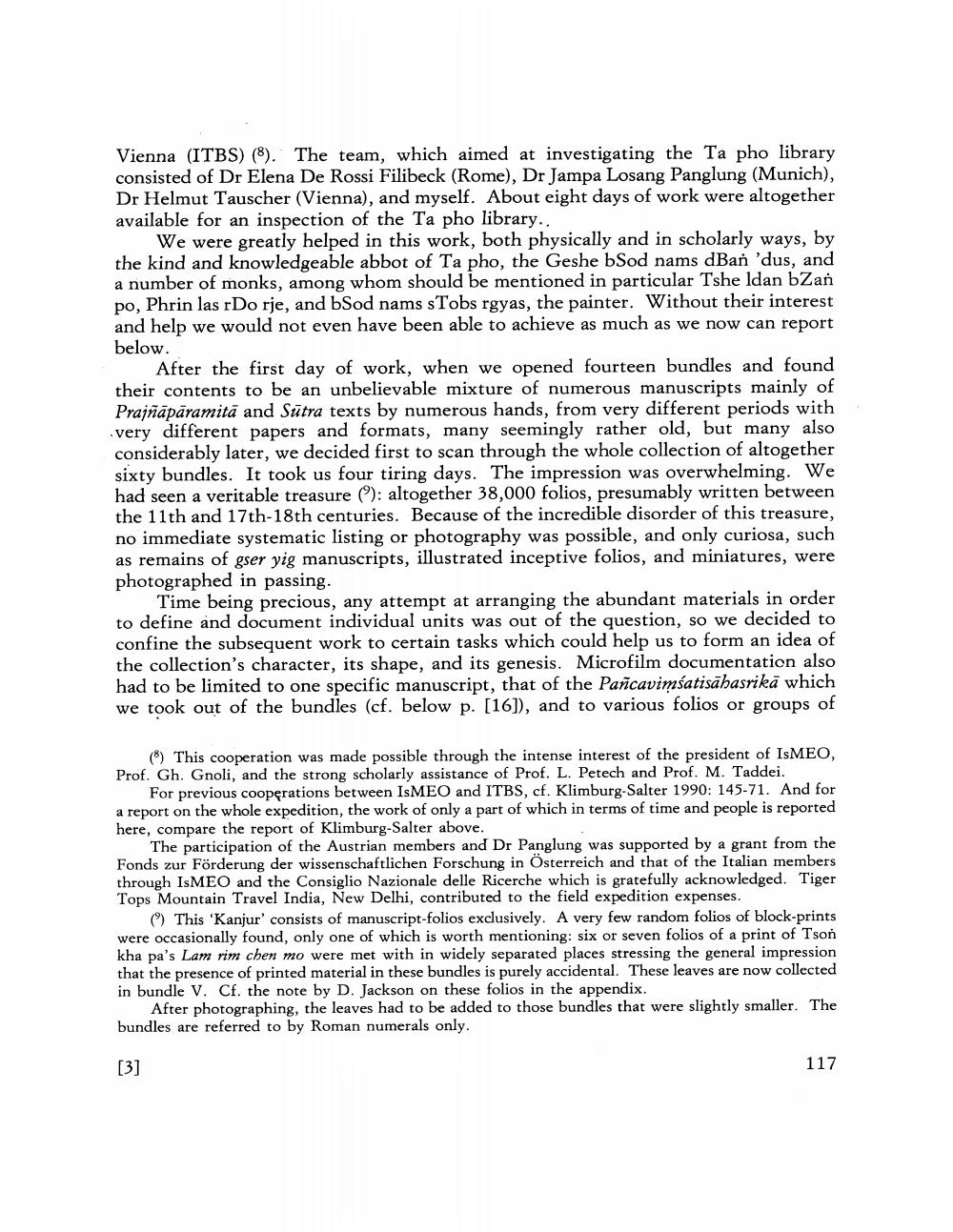Book Title: Report On Kanjur Of Ta Pho Author(s): Ernst Steinkellner Publisher: Ernst Steinkellner View full book textPage 3
________________ Vienna (ITBS) (8). The team, which aimed at investigating the Ta pho library consisted of Dr Elena De Rossi Filibeck (Rome), Dr Jampa Losang Panglung (Munich), Dr Helmut Tauscher (Vienna), and myself. About eight days of work were altogether available for an inspection of the Ta pho library. We were greatly helped in this work, both physically and in scholarly ways, by the kind and knowledgeable abbot of Ta pho, the Geshe bSod nams dBan 'dus, and a number of monks, among whom should be mentioned in particular Tshe ldan bZan po, Phrin las rDo rje, and bSod nams sTobs rgyas, the painter. Without their interest and help we would not even have been able to achieve as much as we now can report below. After the first day of work, when we opened fourteen bundles and found their contents to be an unbelievable mixture of numerous manuscripts mainly of Prajnaparamitā and Sūtra texts by numerous hands, from very different periods with very different papers and formats, many seemingly rather old, but many also considerably later, we decided first to scan through the whole collection of altogether sixty bundles. It took us four tiring days. The impression was overwhelming. We had seen a veritable treasure (°): altogether 38,000 folios, presumably written between the 11th and 17th-18th centuries. Because of the incredible disorder of this treasure, no immediate systematic listing or photography was possible, and only curiosa, such as remains of gser yig manuscripts, illustrated inceptive folios, and miniatures, were photographed in passing. Time being precious, any attempt at arranging the abundant materials in order to define and document individual units was out of the question, so we decided to confine the subsequent work to certain tasks which could help us to form an idea of the collection's character, its shape, and its genesis. Microfilm documentation also had to be limited to one specific manuscript, that of the Pancavimśatisāhasrikā which we took out of the bundles (cf. below p. [16]), and to various folios or groups of () This cooperation was made possible through the intense interest of the president of ISMEO, Prof. Gh. Gnoli, and the strong scholarly assistance of Prof. L. Petech and Prof. M. Taddei. For previous cooperations between IsMEO and ITBS, cf. Klimburg-Salter 1990: 145-71. And for a report on the whole expedition, the work of only a part of which in terms of time and people is reported here, compare the report of Klimburg-Salter above. The participation of the Austrian members and Dr Panglung was supported by a grant from the Fonds zur Förderung der wissenschaftlichen Forschung in Österreich and that of the Italian members through IsMEO and the Consiglio Nazionale delle Ricerche which is gratefully acknowledged. Tiger Tops Mountain Travel India, New Delhi, contributed to the field expedition expenses. () This 'Kanjur' consists of manuscript-folios exclusively. A very few random folios of block-prints were occasionally found, only one of which is worth mentioning: six or seven folios of a print of Tson kha pa's Lam rim chen mo were met with in widely separated places stressing the general impression that the presence of printed material in these bundles is purely accidental. These leaves are now collected in bundle V. Cf. the note by D. Jackson on these folios in the appendix. After photographing, the leaves had to be added to those bundles that were slightly smaller. The bundles are referred to by Roman numerals only. [3] 117Page Navigation
1 2 3 4 5 6 7 8 9 10 11 12 13 14 15 16 17 18 19 20 21 22
